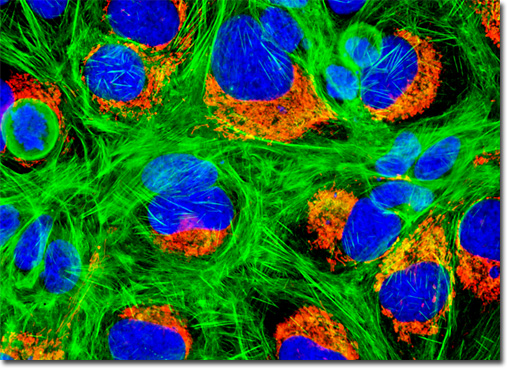Fluorescence Digital Image Gallery
Human Bone Osteosarcoma Cells (U-2 OS)
|
Though most often diagnosed in teenagers, osteosarcoma may affect adults as well, especially those over the age of 50. When the bone cancer occurs in such individuals it is typically associated with Pagetís disease. Named for Sir James Paget, who was the first to describe the condition, Pagetís disease is characterized by abnormal bone destruction and regrowth, and is accompanied by an increase risk for certain kinds of cancer, particularly osteosarcoma. Scientists have not yet been able to determine a cause of the disease and there is no known cure. Several different drugs are available, however, that provide a significant amount of relief to patients by suppressing the breakdown of bone tissue and treating symptoms, such as joint pain, inflammation, and stiffness. The culture of U-2 OS cells presented in the digital image above was transfected with a pDsRed-Mitochondria plasmid subcellular localization vector, thus localizing a red fluorescent protein tag to the intracellular mitochondrial network. Stable transfectants were isolated, grown in monolayer culture, and then fixed, permeabilized, and labeled with a combination of DAPI and Alexa Fluor 488 conjugated to phalloidin, targeting DNA and filamentous actin, respectively. Images were recorded in grayscale with a QImaging Retiga Fast-EXi camera system coupled to an Olympus BX-51 microscope equipped with bandpass emission fluorescence filter optical blocks provided by Omega Optical. During the processing stage, individual image channels were pseudocolored with RGB values corresponding to each of the fluorophore emission spectral profiles. |
© 1995-2025 by Michael W. Davidson and The Florida State University. All Rights Reserved. No images, graphics, software, scripts, or applets may be reproduced or used in any manner without permission from the copyright holders. Use of this website means you agree to all of the Legal Terms and Conditions set forth by the owners.
This website is maintained by our
|
